THE ALMOST NEVER FAIL CATAMARAN ANCHORING
SYSTEM
Exit Only performed the first half of her circumnavigation navigation
using CQR anchors, and the second half using a Beugel anchor.
We started our circumnavigation with a 45 pound CQR, and we dragged it
all over the Pacific Ocean. By the time we reached Tonga, we were tired
of dragging anchor, and we moved up to a 60 pound CQR. We thought that
the additional weight would keep our CQR from dragging. Unfortunately
it didn't work out as hoped.
Even our 60 pound CQR was difficult to set securely in the seabed, and
often we would have to make three attempts at anchoring before it held
fast. Unfortunately, if there was a wind shift or current shift that
reversed the pull on the anchor, we could not trust it to reset in a
secure manner. That made it difficult to leave Exit Only to go ashore
with confidence, because we didn't know whether the anchor was going to
drag while we were away. We always anchored with 200 feet of 3/8 inch
high test chain in addition to the 60 pound CQR.
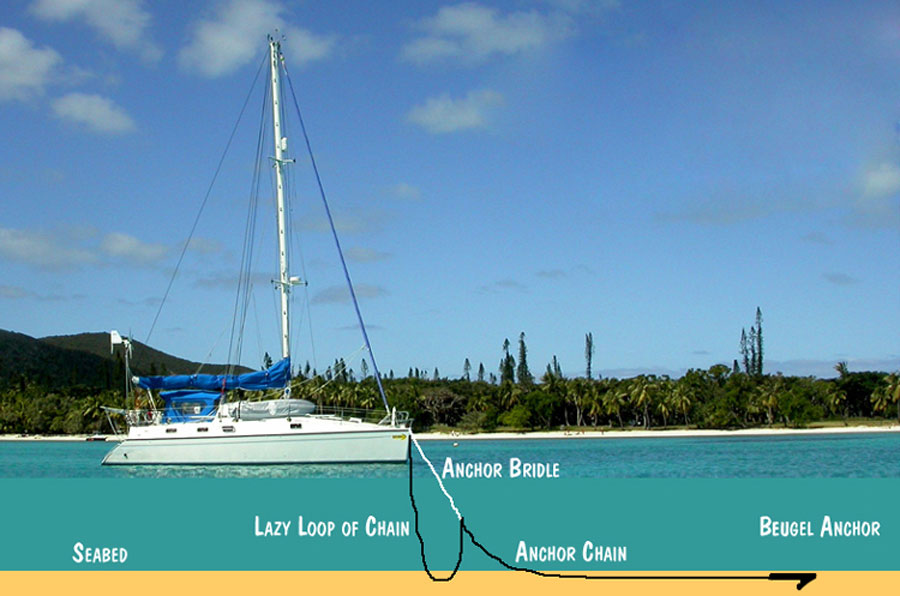
I had resigned myself to an insecure anchoring fate until I cruised with
German yachts in New Caledonia. They had a new anchor called a Beugel.
When we came into an anchorage, they dropped their anchor one time, and
it set securely the first time, every time. In the same seabed, we
attempted to set our CQR two or three times before it held. This
happened time and again. The German yachts anchored closer to shore in
more sheltered conditions because their anchors could be trusted. Their
Beugels always held, and if there was a wind shift, their anchors
quickly reset, while we were struggling to reset our CQR.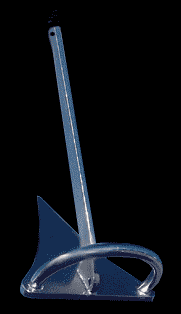
When I arrived in Australia, I decided to get a Beugel Anchor to solve
my anchoring woes. I was tired of dragging anchors and of long anchor
watches.
I purchased a seventy pound Beugel anchor, and it transformed the second
half of my trip around the world. The Beugel anchor stuck to the seabed
like it was covered in superglue. It set quickly in the bottom, it
didn't drag, and if there was a wind shift, it quickly reset in the new
direction. I finally could sleep soundly through the night because I
knew my anchor would hold.
The unique geometry of the Beugel combined
with it's sharp narrow tip means that it penetrates and digs into the
seabed as soon as it hits the bottom. The semicircular tube on the top
of the anchor prevents the anchor from lying upside down on the seabed.
If you have an opportunity to play with a Beugel anchor on dry ground,
you will instantly understand why it digs in so quickly and securely.
In the second half of the circumnavigation (from Australia to Florida),
there were only two occasions when the Beugel had problems. Once in the
Red Sea, we were anchored on a steeply sloping seabed, and we had to
anchor in fifty feet of water. The seabed was so steep that it was
impossible for the Beugel to dig strongly into the bottom. Although we
didn't drag anchor, I could back down on the anchor to seaward and move
the anchor. There was no risk of being blown ashore because in that
direction the Beugel would have held like a champion. The only risk was
being blown offshore by strong winds. It wouldn't have put us in
danger, but it would have been inconvenient.
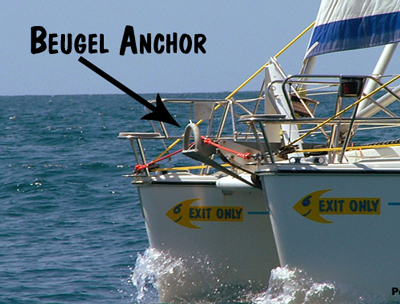
The second time we dragged anchor was in the
Canary Islands in a harbor with a rocky bottom. We were anchored in
about forty feet of water, and when a sub-tropical storm came through,
we dragged anchor. That wasn't a big surprise to us because the bottom
was rocky and deep.
Those were the only two occasions where I had to carefully watch for
dragging of our Beugel anchor. I reckon that is a good record for the
second half of the trip around the world.
The picture at the top of the page shows our customary way of anchoring
Exit Only.
First, we set the 70 lb Beugel anchor in the seabed by snubbing it with
the engines in reverse. The anchor stops Exit Only dead in its tracks,
and we know the anchor is secure.
Second, we use a one inch three strand nylon bridle attached to our two
bows. This bridle acts as a shock absorber and keeps Exit Only pointing
into the wind and seas.

Third, we use an ABI bridle plate to attach our bridle to the chain.
Fourth, we put a large lazy loop of chain into the water. The lazy loop
of chain weighs thirty to forty pounds, and all that weight causes the
bridle to hang nearly straight down from the bow of the boat. When
strong winds and rough seas start to pull hard on the chain, the heavy
lazy loop holds the bridle deep under water. It makes the pull of the
chain on the anchor more horizontal, and it helps prevent shock loads
from being transmitted to the anchor. All of these factors make it less
likely that the anchor will jerk out.
Although no anchor is perfect, the Beugel is the closest thing to
anchoring perfection that I have experienced. I bet my boat on it many
times, and it came through like a champ.
Click on this button to
tell your friends about "The Never Fail Catamaran Anchoring
System".

HOW BIG SHOULD YOUR ANCHOR BE?
That depends.
If you worship at the altar of speed, and if you rarely spend the night
on the hook, then get a light-weight anchor appropriate to the size and
windage of your yacht and to your cruising territory. If you worship at
the altar of security, and if you spend almost every night at anchor,
then get a heavier anchor. If you are a world cruiser, then a heavy
anchor is the order of the day. After all, you want to be sleeping at
night rather than staying up on anchor watch.
Where are you going to be sailing?
If you restrict your movements to an area like the Chesapeake Bay that
has fairly shallow anchorages and a muddy bottom, you can safely get a
light weight anchor that is specifically designed for mud. The odds are
in your favor that you will do fine most of the time.
If you sail from marina to marina, then a smaller and lighter weight
anchor will probably work well. What you need is a lunch hook and
something that will be secure for the rare occasions that you spend the
night anchored out in good weather.
If you sail around the world in your yacht,
then you need to have an all around anchor that is big enough to handle
the most adverse conditions that you encounter during your voyage.
Lightweight anchors might be able to do the job most of the time, but on
many occasions you need a heavy anchor that makes it possible to sleep
at night and makes it safe to leave your boat when you want to explore
ashore. During our circumnavigation, the only places we stayed in
marinas was Colon, Balboa, Australia, Bali, Singapore, Langkawi, Turkey,
Trinidad, Egypt, and Puerto Rico. Whenever possible during out eleven
year voyage, we anchored out. From Turkey to Trinidad, we didn't stay
in any marinas.
On Exit Only, we found that a seventy pound Beugel anchor did the job in
a reliable manner. One of my friends on a fifty-one foot catamaran is
using a one-hundred pound Beugel during his circumnavigation. Seventy
pounds of anchor on a 39 foot cat, and one-hundred pounds of anchor on a
51 foot cat worked extremely well for both of us.
Many catamaran sailors worship at the altar of speed, and they don't
want the weight of a large anchor on their bow. I agree with them
100%. But I also want to sleep at night, and I want to be able to get
off my catamaran and know that Exit Only will still be there when I
return from my visit to shore if the wind pipes up, or if there is a
shift in tidal current.
How big should your anchor be? It should be large enough and heavy
enough that it will safely hold your vessel in the areas that you sail.
If you are going to sail around the world, it would be wise to get a
heavy anchor that will hold your yacht even in stormy conditions.
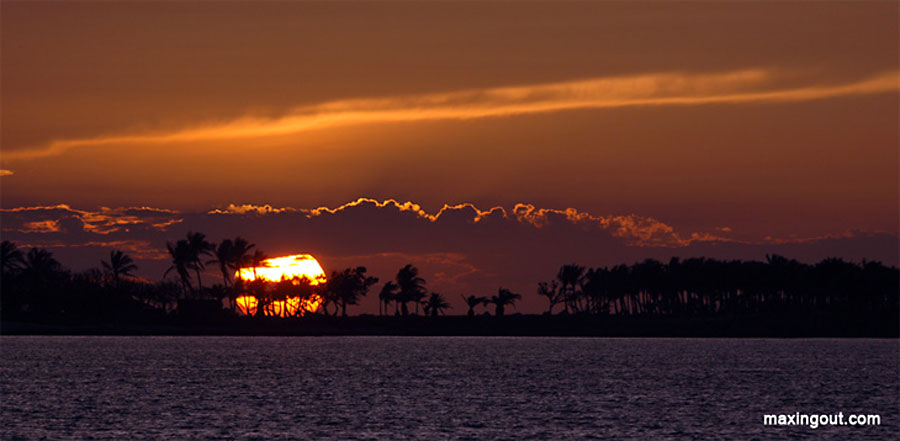
FAR HORIZONS
In my eleven year voyage around the world, I
had the opportunity to experience nearly four-thousand sunrises and
sunsets. That's one of the reasons I like living on a yacht; I have
the privilege of seeing the sun rising in the morning and setting in the
evening.
In
large cities, it's rare to see sunrise and sunset. In the morning you
are still asleep when the sun comes up, and in the evening most people
watch television rather than gaze at the setting sun. It's not
surprising that city dwellers don't see sunrise and sunset. Tall
buildings surround them on all sides making it impossible to view the
horizon. Their sun isn't visible until it is well up in the sky.
Cities are horizon destroyers. When I'm living in a city, distant
horizons aren't part of my world, and I never think about them. I can
only see as far as the other side of the street and down the block; the
horizon isn't anywhere in sight. That's probably one of the reasons why
I don't like living in cities. My world doesn't feel right when I can't
see the horizon. I live in a shrunken world that no longer extends out
to the horizon. My world is a few square feet in size when I'm in an
elevator, and a few square blocks when I'm outside taking a walk. The
dimensions of my world continually shift throughout the day depending on
what I am doing. When I enter the subway, my world shrinks. When I'm
in Central Park, my world expands, but still I live in a horizonless
world.
When
I do expeditionary travel in the desert, my horizon extends out to a
couple of miles, and suddenly I start feeling better. I know that when
the sun goes down, there will be an awesome sunset. The same thing
happens at sea. My horizon extends five miles in every direction, and
sunrise and sunset become a routine part of my world.
Horizons have a salubrious effect on my mind. When I look at the
horizon, I feel my world expand. Not only do I have the pleasure of
watching the sun come up in the morning and set in the evening, I
realize that I can point the bow of my yacht in any direction and sail
over the horizon to a new life.
The horizonless world is unnatural. It's a world of man-made wonders
that don't do much for me. A widescreen TV is a poor substitute for a
real horizon that extends as far as the eye can see. What I'm really
talking about is freedom. If your world has no horizons, then it's
likely you aren't free. You have mortgages, cars, and endless
infrastructure to support in your horizonless world.
When I'm on my yacht, the horizon continually beckons me onward.. I
don't know what will happen over the horizon, but that's ok, because I
am sailing on the ocean of my dreams. I'm living in a world of far
horizons, and life is good.
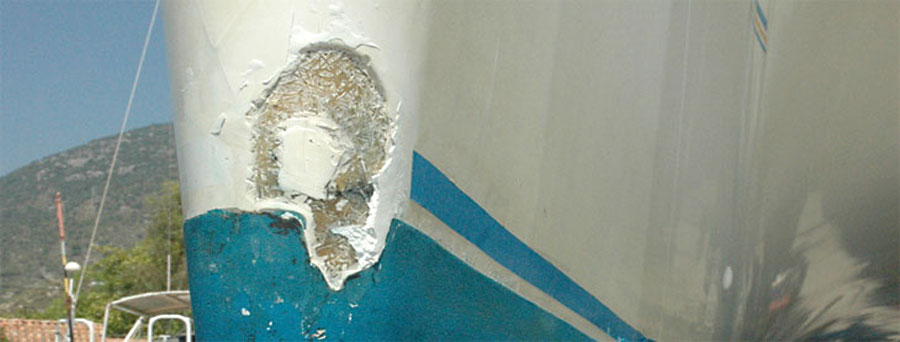
TSUNAMI DAMAGE - THE STARBOARD BOW TAKES
A LICKING AND KEEPS ON TICKING!
In Thailand, Exit Only survived the
most destructive tsunami of modern times without a scratch, but
we didn't escape scot-free. The arm of the tsunami was very
long, and out in the middle of the Indian Ocean, the tsunami
made a lasting impression on Exit Only's starboard bow.
The
starboard bow is the bow of destruction. Two times Exit Only has
collided with things at sea, and it's always the starboard bow that
takes the beating.
When Exit Only left the factory in France, she was sailed to England to
be placed on a ship for delivery to America. Unfortunately, the
delivery captain ran into something and knocked a fist sized hole in the
bow. I don't know what he hit, and believe it or not, he didn't report
the damage. He repaired it with body filler and covered it over with
gel coat. The Privilege dealer in Florida didn't mention the damage,
and I had the boat for a year before I discovered telltale cracks in the
gel coat when I hauled the boat out of the water for a bottom job. Only
then did the dealer tell me about the damage to the bow.
At that point, I was starting a circumnavigation, and it was imperative
that I discover the extent of the damage, and whether it was properly
repaired. I removed the gel coat with a grinder and discovered to my
chagrin that they had put body filler in the hole rather than do a
proper repair using fiberglass. It was the worst type of shoddy
workmanship and substantially weakened the strength of the bow. A
repeated collision at sea could have been disastrous with this
substandard repair.
In the boat yard I exposed the entire area of damage and performed a
professional repair that restored the bow's integrity. I beefed up the
bow to make it more impact resistant in case I ever hit a partially
submerged container or log while at sea. Then I applied new gel coat to
finish the repair.
Exit
Only was never at risk of sinking when holed because there is a
collision bulkhead twelve inches back from the bow. This bulkhead
prevented any significant amount of water from entering the yacht. Only
a few cups of water were in the space ahead of the collision bulkhead.
It was a disappointment to have a hole in the bow of a totally new
yacht, and disappointing that the yacht dealer didn't admit to the
damage until I discovered its tell tale signs a year later, but in the
long haul I may be fortunate that we had the damage to the starboard
bow. Why do I say that?
If I
hadn't beefed up the bow to repair the hidden damage, then when I ran
into a log south of Sri Lanka after the tsunami, it might have put a
devastatingly large hole in the bow rather than just create the gel coat
damage shown in this picture.
One of the things that concern every captain
at sea is the possibility of collision with partially submerged
containers and logs. In the Indian Ocean, some of the floating logs
were more than a hundred feet long and a meter thick. Collision with
such a log can sink a ballasted monohull yacht in under five minutes.
In a catamaran a log won't sink you, but it can cause flooding of one
hull.
You never know ahead of time whether apparent disaster is actually good
or bad. I wasn't happy about the damage to the starboard bow that I
discovered in Fort Lauderdale, but that discovery and repair may have
saved me from a humongous problem in the Indian Ocean eleven years
later.
That's they way things are in life. Although you live in the short
term, life is a long term proposition. What looks like disaster in the
short term, may be a blessing in the long haul. There's truth in the
saying, "What doesn't kill me makes me stronger." It was certainly true
for Exit Only's starboard bow.
I'll take gel coat damage any day when I hit a log in the Indian Ocean.
Repairing gel coat at my leisure in a boatyard is a world better than
having to deal with a gaping hole in the bow in the middle of the Indian
Ocean.
If you want to sail the seven seas, you must become an expert at turning
bad things into better things, and when bad things happen, you might
discover that dealing with the bad thing actually protected you from
something even worse.
When bad things happen, it's not time to put on sackcloth and sit in a
pile of ashes. It's time to keep on keeping on.
It's never over until it's over, and in spite the hole in my starboard
bow, life is still good.
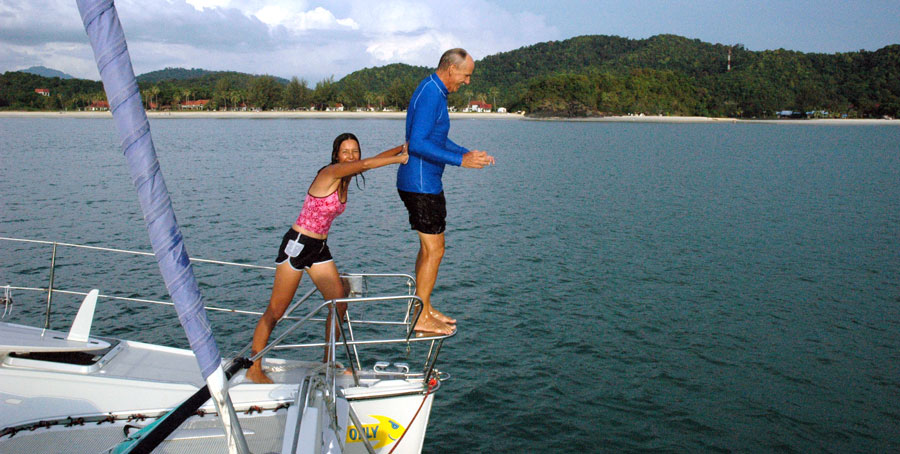
DON'T HESITATE! TAKE THE
PLUNGE NOW AND ORDER
THE RED SEA
CHRONICLES. JUMP INTO A
GREAT CRUISING CATAMARAN DVD. YOU WILL BE GLAD THAT YOU DID!